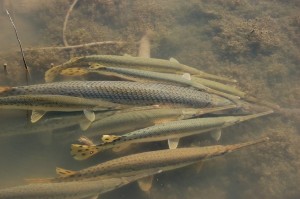Longnose Gar

Longnose Gar (Lepisosteus osseus) Photo from Casey Smartt
Large female surrounded by many smaller males jockeying for position.
Longnose Gar (Lepisosteus osseus) Photo from Casey Smartt
Large female surrounded by many smaller males jockeying for position.
Today’s gars are derived from a group of fish that thrived more than 50 million years ago. Their unusual appearance is due to a long narrow snout that is more than twice as long as the distance from its eye to the back of its head. To exaggerate this appearance, the anal and dorsal fins are located near the rear of the body. These fins have bony spines. Large needle-like teeth on their upper jaws allow them to snare fish with a lateral motion of the head after remaining stealthy still. The sides and top of their bodies are greenish with dark spots on both the sides and fins. The body is covered with armor of thick interlocking scales that native Americans used as arrowheads. They are native to most rivers in the eastern half of Kansas. Their preferred habitat is the cover provided by weedy flats, bends, bays, creek mouths, swamps and backwaters where the water moves slowly. Gars can live in poorly oxygenated water because they have an unusual swim bladder that acts like a primitive lung. This enables them to breathe air directly from the atmosphere. The grown longnose gar preys upon smaller fish including other gar, frogs, snakes, invertebrates such as crabs, and even waterfowl. They usually feed at night. Longnose gar provided a high quality food source for Native Americans. These fish spawn in tightly clustered groups accompanied by dramatic splashing as several males deploy near a female. Although their lifespan ranges from 15-20 years, their population is in decline due to overfishing, pollution, and habitat loss due to construction of dams and roads.
